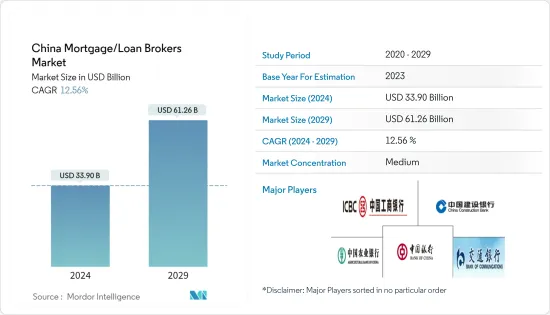PUBLISHER: Mordor Intelligence | PRODUCT CODE: 1431561

PUBLISHER: Mordor Intelligence | PRODUCT CODE: 1431561
China Mortgage/Loan Brokers - Market Share Analysis, Industry Trends & Statistics, Growth Forecasts (2024 - 2029)
The China Mortgage/Loan Brokers Market size is estimated at USD 33.90 billion in 2024, and is expected to reach USD 61.26 billion by 2029, growing at a CAGR of 12.56% during the forecast period (2024-2029).

In China, only nine major state-owned specialized banks are allowed to accept deposits and conduct banking business. Revenue from the wholesale banking Industry in China has continuously declined over the last few years. In the loan industry for household loans, short-term loans consist of a large amount compared to mid- and long-term loans.
With the advent of COVID-19 and its major impact on Chinese businesses and shutdown made at a large level, per capita income of rural and urban households observed continuous growth during that period with a significant disruption of increasing wealth gap in China. This can be observed through a steady Gini coefficient in China at an average of 47 over the decade.
The inflation rate in China is standing at a very low level compared to other countries at around 2.8% and is further expected to remain at the same level. An increase in global interest rate with a spillover effect caused by the US fed with appreciation in dollar value had caused China's central bank to increase the interest rate to control inflation. As the loan market has interest rates as one of the major factors in the banking business, in China's case, this trend will define the future of the Loan mortgage market.
China Mortgage/Loan Brokers Market Trends
Change in Monetary factors affecting China Mortgage/Loan Brokers market.
China has continuously declined its base rate, with the current rate standing at 3.650%. As interest rate plays a major role in economic activities, an increase in interest signifies a trend of increase in inflation. In contrast, a reduction in interest signifies accommodative policies of banks and financial institutions for increasing economic activities and investments. With a decline in interest rate, mortgage loans play a major role when there is no collateral. Therefore, a decline in interest rates will allow the people of China to access a loan without any collateral.
Other than this, an increase in land and real estate prices makes, lending agencies assured of being able to recover in case of a default. Real estate had observed a continuous increase in sales prices in China, creating a positive outlook for borrowers and loan-issuing agencies for mortgage loans.
Banking Penetration affecting Loan Mortgage Real estate market.
As a developed nation and an economic hub globally, China connected almost 80% of its population to banking facilities, making it easier for them to deposit and credit money. With a continuous increase in mobile internet users, all the banking facilities are available on mobile through which people can apply for mortgage loans, and banks can make their facilities available to customers without making them arrive in person.
For state-owned commercial banks, the total loan amount had continuously increased, rising to 103 trillion Yuan (14.56 USD trillion) last year. With all these increases in banking penetration, a negative effect is also been observed with an increasing Non-performing loans, making banks take a precautionary approach while lending.
China Mortgage/Loan Brokers Industry Overview
China, as one of the largest economies globally, is operating with four major banks, which include the Industrial and Commercial Bank of China, The China Construction Bank, The agriculture Bank of China and the Bank of China. These banks are under the direct control of the state. Other than these Largest banks by asset size operating in China are the Postal Saving Bank of China, Industrial Bank (China), China Merchants Bank, China Minsheng Bank, China Citic Bank and Ping An Bank, etc.
Additional Benefits:
- The market estimate (ME) sheet in Excel format
- 3 months of analyst support
TABLE OF CONTENTS
1 INTRODUCTION
- 1.1 Study Assumptions and Market Definition
- 1.2 Scope of the Study
2 RESEARCH METHODOLOGY
3 EXECUTIVE SUMMARY
4 MARKET DYNAMICS AND INSIGHTS
- 4.1 Market Overview
- 4.2 Market Drivers
- 4.2.1 Surge in China household Wealth
- 4.2.2 Increasing Penetration rate among investors
- 4.3 Market Restraints
- 4.3.1 Competition from Western Banks and tightening of risk management rules.
- 4.3.2 Requirement of fresh Capital for financing
- 4.4 Market Opportunities
- 4.4.1 Fintechs Innovative products expanding the Market
- 4.4.2 The partnership between fintech and traditional Banks towards a more stable business
- 4.5 Industry Attractiveness - Porter's Five Forces Analysis
- 4.5.1 Bargaining Power of Buyers
- 4.5.2 Bargaining Power of Suppliers
- 4.5.3 Threat of New Entrants
- 4.5.4 Threat of Substitutes
- 4.5.5 Intensity of Competitive Rivalry
- 4.6 Insights of Technology Innovations in the Market
- 4.7 Insights on various regulatory landscape
- 4.8 Impact of COVID-19 on the Market
5 MARKET SEGMENTATION
- 5.1 By Type of Mortgage Loan
- 5.1.1 Conventional Mortgage Loan
- 5.1.2 Jumbo Loans
- 5.1.3 Government-insured Mortgage Loans
- 5.1.4 Other Type of Mortgage Loans
- 5.2 By Mortgage Loan Terms
- 5.2.1 30- years Mortgage
- 5.2.2 20-year Mortgage
- 5.2.3 15-year Mortgage
- 5.2.4 Other Mortgage Loan Terms
- 5.3 By Interest Rate
- 5.3.1 Fixed-Rate
- 5.3.2 Adjustable-Rate
- 5.4 By Provider
- 5.4.1 Primary Mortgage Lender
- 5.4.2 Secondary Mortgage Lender
6 COMPETITIVE LANDSCAPE
- 6.1 Market Concentration Overview
- 6.2 Company Profiles
- 6.2.1 Bank of Japan
- 6.2.2 Bank of China
- 6.2.3 Suruga bank Ltd.
- 6.2.4 SMBC trust bank
- 6.2.5 Shinseibank
- 6.2.6 United Overseas Bank
- 6.2.7 Overseas Chinese Banking Corp
- 6.2.8 Sumitomo Mitsui Financial Group
- 6.2.9 Mitsubishi UFJ Financial Group
- 6.2.10 Mizuho Financial Group*
7 MARKET FUTURE TRENDS
8 DISCLAIMER AND ABOUT US




